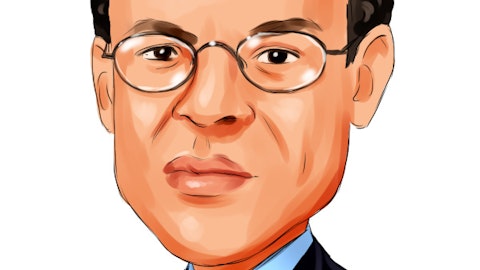Capital Southwest Corporation (NASDAQ:CSWC) Q3 2023 Earnings Call Transcript January 31, 2023
Operator: Thank you for joining today’s Capital Southwest Third Quarter Fiscal Year 2023 Earnings Call. Participating on the call today are Bowen Diehl, CEO; Michael Sarner, CFO; and Chris Rehberger, VP Finance. I will now turn the call over to Chris Rehberger.
Chris Rehberger: Thank you. I’d like to remind everyone that in the course of this call, we will be making certain forward-looking statements. These statements are based on current conditions, currently available information and management’s expectations, assumptions and beliefs. They are not guarantees of future results and are subject to numerous risks, uncertainties and assumptions that could cause actual results to differ materially from such statements. For information concerning these risks and uncertainties, see Capital Southwest’s publicly available filings with the SEC. The company does not undertake any obligation to update or revise any forward-looking statements, whether as a result of new information, future events, changing circumstances or any other reason after the date of this press release, except as required by law. I will now hand the call off to our President and Chief Executive Officer, Bowen Diehl.
Bowen Diehl: Thanks Chris, and thank you to everyone for joining us for our third quarter fiscal year 2023 earnings call. We are pleased to be with you this morning and look forward to giving you an update on the performance of our company and our portfolio as we continue to diligently execute our investment strategy as steward of your capital. Throughout our prepared remarks, we will refer to various slides in our earnings presentation, which can be found on our website at www.capital southwest.com. You also find our quarterly earnings press release issued last evening on our website. We’ll begin on slide six of the earnings presentation where we have summarized some of the key performance highlights for the quarter. During the quarter, we generated pretax net investment income of $0.60 per share, which represented 11% growth over the $0.54 per share generated in the prior quarter and 18% growth over the $0.51 per share generated a year ago in the December quarter.
The $0.60 per share more than earned a regular dividend paid during the quarter of $0.52 per share, while also covering the supplemental dividend paid during the December quarter of $0.05 per share. We were also pleased to announce today that our Board has declared another $0.01 per share increase in our regular dividend to $0.53 per share for the quarter ending March 31st, 2023. This increase represents 1.9% growth over the $0.52 per share paid in a December quarter and 10% growth over the $0.48 per share paid a year ago in the March quarter. These increases in our regular dividend are a result of the increased fundamental earnings power of our portfolio, dividends growth and performance, as well as improvements in our operating leverage. In addition, due to the continued excess earnings being generated from by our floating rate debt investment portfolio, our Board of Directors has again declared a supplemental dividend of $0.05 per share for the March quarter, bringing total dividends declared for the March 23 quarter to $0.58 per share.
While future dividend declarations are at the discretion of our Board of Directors, it is our intent and expectation that Capital Southwest will continue to distribute quarterly supplemental dividends for the foreseeable future while base rates remain materially above long-term historical averages. Finally, I should note that as we have done in the past, we intend to also distribute additional supplemental dividends as we harvest realized gains from our equity coinvestment portfolio. During the quarter, we saw strong deal activity in the lower rental market, primarily focused on acquisitions rather than in refinance. The environment during the quarter was a favorable one for a first lean lender like Capital Southwest. We saw average spreads that were 50 to a 100 basis points wider than a year ago with leverage levels on our new platform deals that were a lower — that were lower by a full turn of EBITDA.
Interestingly, loan to value levels on new deals calculated as our firstly loan divided by the enterprise value being paid for an acquisition were also down meaningfully. This suggests that multiples being paid for strong companies remained robust. Portfolio growth during the quarter was driven by 164 million in new commitments consisting of commitments to five new portfolio companies totaling 122.4 million and add-on commitments to 12 existing portfolio companies totaling 41.6 million. This was offset by 12.4 million in proceeds from one debt prepayment and warrant equity sale during the quarter. On the capitalization front, we raised a total of $104.3 million in gross equity proceeds during the quarter at a weighted average price of $17.99 per share, or 109% of the prevailing NAV per share.
This included $58.3 million raised through our equity ATM program and $46 million raised through an underwritten public equity offering. Our liquidity remains robust with approximately $196 million in cash and undrawn capital commitments as of the end of the quarter. We have remained diligent in funding a meaningful portion of our investment asset group with creative equity issuances, and we think it is critical that we maintain a conservative mindset to BDC leverage given the uncertainty of the economy. As we have spent many times we manage our BDC with a full economic cycle mentality. This starts with the underwriting of our new opportunities, but it also applies to how we manage the BDCs capitalization. Managing leverage to the lower end of our target range positions us to invest throughout a potential recession when risk adjusted returns can be a particularly attractive.
It also allows us to support our portfolio companies will also opportunistically repurchasing our stock if it were to trade meaningfully below NAV. With business context, we are very pleased with the strength of our balance sheet as we reduced regulatory leverage to 0.91 to 1 from 1.11 to one in the prior quarter. We maintained our significant liquidity position, and we continue to operate with almost half of our balance sheet liabilities and fixed rate unsecured covenant free bonds, the earliest of which mature in 2026. On slide seven-eight, we illustrate our continued track record of producing strong dividend growth, consistent dividend coverage and solid value creation since the launch of our credit strategy back in January of 2015. Since that time, we have increased our regular dividend paid to shareholders 25 times and have never cut the regular dividend, including during the tumultuous environment we all experienced during the COVID pandemic.
Additionally, over the same time period, we have paid or declared 19 special or supplemental dividends, totaling $3.60 per share generated from excess earnings and realized gains from our investment portfolio. We believe our track record of consistently growing our dividend, the solid performance of our portfolio, as well as our company’s sustained access to the capital markets has demonstrated the strength of our investment and capitalization management strategies, as well as the absolute alignment of our decisions with the interest of our shareholders. Continuing to generate this strong track record, we believe is critically important to building long-term shareholder value. Turning to slide nine. Our investment strategy is laid out for our shareholders at its launch back in January, 2015 hasn’t changed.
The vast majority of our activity has been in our core lower middle market where we are the first lean senior secured lender, most often backing a private equity firm’s acquisition of a growing lower middle market company. We also often participate on a minority basis in the equity of the company through — in the equity of the company through an equity coinvestment made alongside the private equity firm. In fact, 90% of our credit portfolio is backed by private equity firms, which provide important guidance and leadership to the portfolio companies, as well as the potential for new junior capital support if needed. Our lower middle market strategy is complimented by club participations in larger companies, led by like-minded lenders with whom we have relationships and have gained confidence in their post-closing loan management from working well together across multiple deals.
Virtually all of these club deals are also backed by private equity firms. And so the end of the quarter, our equity coinvestment portfolio consisted of 48 investments with a total fair value of $112.1 million, which was 60% over our cost, representing $41.8 million in embedded unrealized appreciation of $1.21 per share. Our equity portfolio, which represented approximately 10% of our total portfolio at fair value is at the end of the quarter continues to provide our shareholders participation in attractive upside potential of these growing lower middle market businesses, which will come in the form of NAV per share and supplemental dividends over time. As illustrated on slide 10, our on balance sheet credit portfolios of the end of the quarter, excluding our I-45 senior loan funds, grew 10% to $990 million as compared to $903 million as of the end of the prior quarter.
Over the past year, our credit portfolio has grown by $245 million or 33% from $745 million as of the end of December of 2021 quarter. For the current quarter, 99.7% of our new portfolio company debt originations were first lean senior secured debt, and as of the end of the quarter, 96% of our total credit portfolio was first leaned senior secured. On slide 11 and 12, we detailed the $164 million of capital invested and committed to portfolio companies during the quarter. Capital committed this quarter included $120.4 million in first lean senior secured debt and $1.6 million in equity coinvestments to five new portfolio companies. Additionally, we committed $39.7 million in first lean senior secured debt and $1.9 million in equity coinvestments to existing portfolio companies during the quarter.
Turning to slide 13. During the quarter we had one debt prepayment and one equity sale. In total, these exits generated approximately $12.4 million in total proceeds generating a weighted average IRR of 10.1%. Since the launch of our credit strategy eight years ago, we have realized 67 portfolio exits representing $775 million in proceeds that have generated a cumulative weighted average IRR of 14.6%. The market for acquisition capital continues to be active. Not surprisingly, given the widening spreads on new loans in the market, the slowdown and refinancing activity continues. So, on a net basis, we expect solid net portfolio growth in near-term. We are pleased with the strong market position that our team has established in the lower middle market as a premier debt and equity capital provider, as evidenced by the broad array of relationships across the country from which our team is sourcing quality opportunities.

Photo by Towfiqu barbhuiya on Unsplash
In terms of deal origination, we find that underwriting certain industries is more challenging given today’s economic uncertainty. However, an important component of our underwriting has always been to run a stress case downside model for every new deal, simulating an extreme recession occurring soon after closing. But many respects our underwriting in the current environment hasn’t changed. Although, our models today include much higher base rates than we have experienced historically. Our fundamental analysis attempts to tie the leverage level we are willing to put on a company to the potential performance volatility of a particular business in industry throughout the economic cycle. Performance across different industries can be very different through the economic cycle, so getting this right is an important component of the underwriting process.
Specifically in a stress case financial model, we require the fundamental underwriting standard that we see our loan remain well within the portfolio company’s enterprise value and the portfolio company’s cash flow able to cover our loan interest throughout the cycle. On slide 14, we detailed some key stats for our unbalanced sheet portfolio as of the end of the quarter, again excluding our I-45 senior loan fund. As of the end of the quarter, the total portfolio at fair value was weighted approximately 87% to first lien senior secured debt, 3.2% to second lien senior secured debt, 0.1% to subordinated debt, and 10.2% to equity coinvestments. Credit portfolio had a weighted average yield of 12% and weighted average leverage through our security of 3.6 times.
The weighted average leverage this quarter was down from 4.1 times in the prior quarter due in part to $67.3 million of funded debt originations to five new portfolio companies at a weighted average leverage through our security of 1.9 times EBITDA. Turning to slide 15. We have laid out the rating migration within our portfolio. As a reminder, all loans upon origination are initially assigned an investment rating of two on a four point scale, with one being the highest rating and four being the lowest rating. We feel very good about the performance of our portfolio with 95% of the portfolio at fair value rated in one of the top two categories a one or a two. As illustrated on slide 16, our total investment portfolio, including our I-45 senior loan fund, continues to be well diversified across industries with an accurate mix, which provides strong security for our shareholders capital.
The portfolio remains heavily weighted towards first line senior secured debt with only 3% of the total portfolio secondly in senior secured debt. I’ll now hand the call over to Michael to review some specifics of our financial performance for the quarter.
Michael Sarner: Thanks Bowen. Specific to our performance for the December quarter, let’s summarize on slide 18. We increased pretax net investment income 25% quarter-over-quarter to $18.7 million compared to $15 million last quarter. Pretext NII was $0.60 per share for the quarter. During the quarter, we paid out a $0.52 per share regular dividend and a $0.05 per share supplemental dividend. As mentioned earlier, our Board has approved an increase to the regular dividend for the March quarter to $0.53 per share and declared another $0.05 per share supplemental dividend for the quarter. Maintaining a consistent track record meaningfully covering our dividend with pretext NII is important to our investment strategy. We continue our strong track record of regular dividend coverage with 108% for the last 12 months and December 31st, 2022, and 107% cumulative since the launch of our credit strategy in January, 2015.
Given the floating rate nature of our credit portfolio, elevated interest rates continued to be a significant tailwind to our net investment income. The base rate index used to calculate interest on a majority of our loans reset in early January to 4.75% up from its early October reset at 3.75%. This significant increase quarter-over-quarter will provide another immediate step up in portfolio income in the March quarter. With that as context, we’ll continue to execute our policy of having regular dividends follow the trajectory of recurring pretext NII per share. As such, we expect to thoughtfully increase our regular dividend to a level which can be sustained should base rates return to a neutral level. In addition, while base rates remain elevated, our intent is to distribute a portion of excess pretext NII to our shareholders each quarter through supplemental dividends.
Based upon our current UTI balance of $0.34 per share, the ability to grow UTI each quarter organically by overrunning our dividend and harvesting gains from our existing $1.21 per share in unrealized appreciation on the equity portfolio, we are confident in our ability to continue to distribute quarterly supplemental dividends for the foreseeable future. For the quarter, we increase total investment income from our portfolio of 22% quarter-over-quarter to $32.8 million, producing a weighted average yield on all investments of 11.7%. Total investment income was $6 million higher this quarter due to a higher average balance of credit investments outstanding. In addition to the tailwind provided from increases in LIBOR and SOFR base rates. As at the end of the quarter, we had approximately $4 million of our investments on nonaccrual representing 0.3% of our investment portfolio at fair value.
Finally, the weighted average yield on our loan portfolio was 12% for the quarter. As seen on slide 19, we further improved LTM operating leverage to 1.9% as of the end of the quarter, achieving 2% or lower operating leverage was one of our initial long-term goals when we relaunched Capital Southwest as a middle market lender back in 2015, so we were pleased to have reached this milestone. Looking ahead, we expect our internally managed structure to produce additional improvements in operating leverage. Turning to slide 20. The company’s NAV per share at the end of the December quarter decreased by $0.28 per share to $16.25 cents, representing a decrease of 1.4% before giving effect to the supplemental dividend paid for the quarter. The primary drivers of the NAV per share decrease for the quarter included $8.5 million of net unrealized depreciation on the on balance sheet debt portfolio, $1.2 million, unrealized depreciation on the equity portfolio, and $3.3 million of unrealized depreciation on the I-45 portfolio.
The vast majority of which was mark-to-market quote activity in the syndicated market. We also generated a total of $0.17 per share of accretion from the issuance of common stock at a premium to NAV per share. Turning to slide 21. As Bowen mentioned earlier, we are pleased to report that our balance sheet liquidity remains strong, with approximately $196 million in cash and undrawn leverage commitments on our revolving credit facility as at the end of the quarter. Based on our credit facility borrowing base as at the end of the quarter, we have full access to the incremental revolver capacity and we’ll look to opportunistically increase commitments to the facility in the future. Our banks syndicate continues to support our growth, and we’re pleased with the flexibility and the revolving credit facility provides to our capital structure.
In addition, we have $26 million in committed, but unfunded SBA to ventures to be used to fund future SBIC eligible investments. As of December 31st, 2022, approximately 47% of our capital structure liabilities were unsecured and our earliest debt maturity is in January, 2026. A regulatory leverage as seen on slide 21, ended the quarter at a debt to equity ratio of 0.91 to one down significantly from 1.23 to one as of December, 2021 quarter. Over the past couple years, we’ve made a considered effort to strengthen our balance sheet to ensure we are prepared for any macro economic headwinds that we may encounter. These efforts have included our opportunistic unsecured bond issuances at record low rates in the late calendar 2021. Our continued support from banking relationships which have followed — which have allowed for steady growth in our revolver facility commitment and our continued diligence in moderating leverage through a creative equity issuance in utilizing both our ATM program as well as the secondary equity market.
We’ll continue to work towards strengthening balance sheet, ensuring adequate liquidity and maintaining conservative leverage in covenant cushions throughout the economic cycle. And I’ll now hand the call back to Bowen for some final comments.
Bowen Diehl: Thanks Michael, and again, thank you everyone for joining us today. We appreciate the opportunity to provide you an update on our business, our portfolio and the market environment. Our company and portfolio continue to perform well, and I continue to be impressed by the job our team has done in building a robust asset base deal origination capability, as well as a flexible capital structure. Based to the uncertainty in the economy again, we have been underwriting with a full economic cycle mentality since day one, which we believe has positioned us well for the potential economic volatility in the coming months and years. In summary, we have a boarding rate credit portfolio heavily weighted to first lean senior secure debt allocated across a broader array of companies and industries, 90% of which is backed by private equity firms.
We have a well capitalized balance sheet with diverse capital sources, strong liquidity and flexible capital, much of which is fixed rate and covenant life. We believe our first lean senior security investment focus and our capitalization strategy provide us complete confidence in the health and positioning of our company and our portfolio as we look ahead. This concludes our prepared remarks. Operator, we are ready to open the lines up for Q&A.
See also 13 Cheap New Stocks To Buy and 10 Dirt Cheap Stocks To Buy.
Q&A Session
Follow Capital Southwest Corp (NASDAQ:CSWC)
Follow Capital Southwest Corp (NASDAQ:CSWC)
Operator: Thank you. And our first question comes from the line of Mickey Schleien with Ladenburg. Your line is open. Please go ahead.
Mickey Schleien: Yes. Good morning, everyone. Bowen, in the fourth quarter we continue to see spreads in the middle market widen a little bit more, which is obviously helpful for your company’s financial performance. So, I’d like to ask you, what’s your outlook on how private lenders will behave going forward this year in terms of spread? When we think about the fact that LIBOR and SOFR have already climbed a lot and that stresses borrowers and what types of floors are you getting nowadays?
Bowen Diehl: Yeah. Thanks Mickey. I’ll answer them in reverse order. So, we’re pretty regularly getting 2% floors on the loans. And as far as what the market will do, spreads clearly widened. We address that in our prepared remarks and leverage levels will come down that we’re seeing, which is attractive. That’s a nice time to be a first lean lender. As far as what the market does in spread going forward, it’s an interesting question. I mean in past cycles, candidly the lending market can tend to basically enjoy the increased index and bring in spreads by a small amount, 25 basis points or so, 50 basis points. I don’t know what they’ll do that this time or not, it seems to be that there’s a lot of liquidity in the private equity market and the pipeline seems to be solid. So, I want to see — I don’t know, I mean, in past cycles, there has been trade-offs between spread and index, but it’s hard to tell. We don’t see that right now, for sure.
Mickey Schleien: Appreciate that. And Bowen, the portfolio’s average debt to EBITDA declined quite a bit this quarter. I think you mentioned that some of that was due to new investments at lower multiples. But we’ve also seen data that somewhat surprisingly middle market company EBITDA growth on average rebounded pretty nicely in the fourth quarter. So, could you give us a sense of how your portfolio companies are performing in terms of their revenues and margins?
Bowen Diehl: Yeah. We had kind of two factors that brought that ratio down. One is what I referenced. The other one is we had a couple of names that had very low EBITDA so very high leverage ratios, and that EBITDA went from slightly positive to slightly negative. So that really a significant move from a credit picture perspective, but a very high multiple of a positive EBITDA. EBITDA goes to slightly negative, and there’s not really a way to calculate that on the average. So, we — basically, we had a couple of very high level or high leverage names move out of the average that brought the average down. But organically, if you look at the — without that, leverage went from 4.1 times down to 3.9 times to give you an idea. So, across the portfolio.
I would say our weighted average EBITDA across the portfolio. Revenue was up and EBITDA was basically flat. So, weighted average basis, we had some nice winters and some flat. But basically, it was EBITDA is basically flat for the quarter.
Michael Sarner: I mean, revenue we saw, Mickey, we’re still increasing, but at a slower clip than in previous quarters. And we think maybe potentially we’re peaking on inflationary impacts in terms of cost — that remains to be seen, but that kind of resulted in still being high and us having flat EBITDA-ish, but even though revenue was up.
Mickey Schleien: Okay. I understand. And that’s a nice segue into my next question. You have several investments in the consumer sector, at least if we look at the SOI, the word consumer shows up. And we’re seeing data that the consumer is really starting to retrench now. So, could you give us some insight into how your — specifically your consumer related investments are performing and what you think their outlook is this year?





